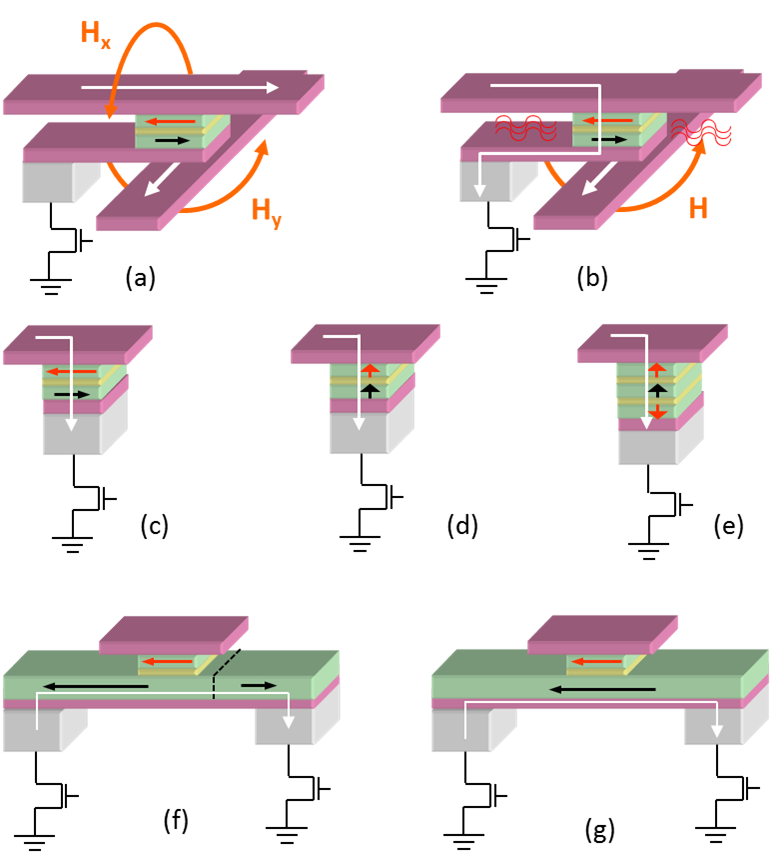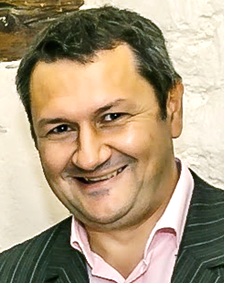Thematic overview
Magnetic Random Access Memories (MRAM) is a non-volatile memory technology, where information is stored by the magnetization direction of magnetic electrodes, very similar to computer hard-disk drives. The goal for MRAM memory is to simultaneously achieve high-speed read/write times, high density and unlimited cycling compared to other existing and emerging technologies.
Our group is developing advanced MRAM cell concepts patented at Spintec. The concepts are based on the use of temperature to reduce power consumption and increase the stability of the stored information. These ideas go beyond the conventional MRAM approach. The naturally occurring temperature increase during the write step is not lost, but is instead used to achieve the seemingly opposing goal of lowering the power consumption and increasing the thermal stability in the operating temperature range. Our group fosters young and experienced researchers developing/applying their expertise in the field of MRAM.

Questions to be addressed
Our main research axis is to use the naturally occurring temperature increase during the write step, when a current flows through the magnetic tunnel junction. The heating is used to go above a temperature threshold, making it possible to write the storage layer magnetization. This principle has been applied to in-plane magnetization cells using a storage layer pinned by an anti-ferromagnet and recently to perpendicular anisotropy cells. Our group’s goal is to demonstrate the proof-of-concept and then improve MRAM cell properties.
Our work involves the development of magnetic material systems, nano-fabrication (20-200nm cells), characterization of devices (magnetic & electrical) and simulation of the device behavior. Our activity in these vast fields is as follows;: On materials research, we are developing magnetic tunnel junctions with in-plane and perpendicular magnetic anisotropy. New electrode stacks having the material properties required by each specific concept need to be integrated in magnetic tunnel junctions, while achieving high levels of TMR signal. For the characterization of each concept we determine the write window parameters in terms of magnetic field, power consumption and magnetization reversal dynamics. Macrospin and micromagnetic simulation provide a better physical understanding of the system properties and the possibilities for optimization.
Projects
ANR EXCALYB – Perpendicular Anisotropy Materials for High-Density Non-volatile Magnetic Memory Cells
Crocus R&D – Thermally assisted MRAM
Samsung SGMI
Partners
Crocus Technology
Institut Néel
SP2M/NM
SAMSUNG
Applied Materials
SINGULUS
Recent news
- 18 months post-doc position: pMTJs for memory and microwave devices [November 16th, 2016]
In the frame of our H2020 project GREAT we have one open position for a postdoc or term contract for 18 months to characterize the spin transfer torque induced magnetic switching as well as rf ... - SPINTEC’s spinoff HProbe offers 3D magnetic probers [November 03rd, 2016]
HProbe is the latest spin-off company from SPINTEC, based on our expertise in MRAM research at the wafer scale. HProbe offers a 3D magnetic field wafer-level electrical tester for all types of MRAM (STT, SOT, ... - Misalign to write faster [October 17th, 2016]
The writing in conventional magnetic memories based on magnetic tunnel junctions (STT-MRAM) is intrinsically stochastic : a large amplitude thermal fluctuation is required to trigger the siwthing of the storage layer magnetization. SPINTEC has shown ... - Editor – Proceedings of the IEEE, Special issue on Spintronics [October 01st, 2016]
Special issue on Spintronics, published in the proceedings of the IEEE, vol.104 (10), October 2016 Editors: Hideo Ohno, Mark Stiles, Bernard Dieny - Master students to visit SPINTEC and discuss our topics for internships [September 18th, 2016]
On 25th October 2016 our host Institut INAC welcomes students for a presentation of internship topics proposed to host Master-2 students during Spring 2017. Details will be provided later.

SOUSA Ricardo
ricardo.sousa@cea.fr

BALTZ Vincent
vincent.baltz@cea.fr

PREJBEANU Lucian
lucian.prejbeanu@cea.fr

DIENY Bernard
bernard.dieny@cea.fr





